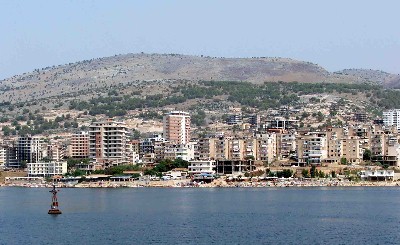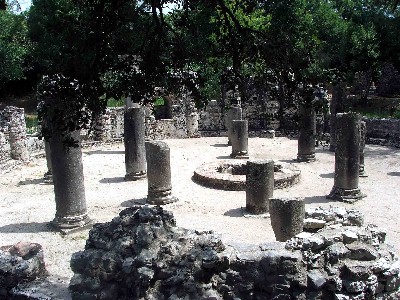This map is from the Lonely Planet web site, a fine source of
travel information. Click
here
to learn more about traveling in Albania (it will appear in a new window.)
 |
We didn't sail from Greece up the Ionian to Albania, but we
could have. Albania's relations with the rest of the world have recently
thawed, and a short ferry ride from Corfu takes you to the resort of
Saranda, shown at left. This port is a favorite for Albanians from the
capital of Tirsani, and it's a preferred spot for honeymoons.
Some ruins just off of the town's harbor were discovered twenty years
ago. It has just been determined that the building was an ancient
synagogue, complete with Jewish imagery depicted on the floor mosaics. |
| The ancient site of
Butrint contains several millennia of ruins that hadn't been excavated
much at all until recently. Virgil likens Butrint to Troy in the Aeneid, and
it's likely that Julius Caesar established a settlement there. The rich
vegetation that had covered it up means that the ruins are in fairly good
shape.
In the fourth century BC, the Greeks built a sanctuary to the god of
medicine Asclepius. Nearby, they built this theater, which had several
uses. It was a theater for entertainment, it was a chamber for the
council of elders, and it served as a religious meeting place for the
citizens. The 23 rows of seats held an audience of 2,500. The Romans
added some architecture to the stage and the seating areas. They used
the theater for gladiator fights. |
 |
 |
When the Emperor Constantine established Christianity in 330
AD, baptisteries and other religious buildings were erected throughout the
empire. The baptistery at left was built in the sixth century AD. This is
what is left of the original sixteen columns placed in two concentric
circles. On the floor was a mosaic containing the tree of life and some
intricate animal motifs. |
| Butrint was a major port during the Byzantine
era, connecting Venice with Constantinople (now Istanbul.) This large
basilica attests to the size of the settlement during this period.
Butrint's strategic location made it a target for invaders. The Normans
conquered Butrint in the eleventh century, and then the area fell to the
Angevins in the fourteenth century. The Venetians took over in the
fourteenth century, and though they held Butrint, they struggled against
the Ottomans from 1537 until the eighteenth century, with Butrint
changing hands several times over the years.
|
 |


